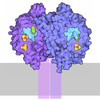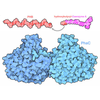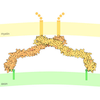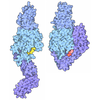+ Open data
Open data
- Basic information
Basic information
| Entry | Database: PDB / ID: 9hq4 | ||||||
|---|---|---|---|---|---|---|---|
| Title | TTLL11 bound to microtubule | ||||||
 Components Components |
| ||||||
 Keywords Keywords | LIGASE / TTLL11 / polyglutamylase / tubulin / microtubule | ||||||
| Function / homology |  Function and homology information Function and homology informationtubulin-glutamic acid ligase activity / protein-glutamic acid ligase activity, initiating / protein-glutamic acid ligase activity, elongating / microtubule severing / Ligases; Forming carbon-nitrogen bonds; Acid-amino-acid ligases (peptide synthases) / odontoblast differentiation / Post-chaperonin tubulin folding pathway / Cilium Assembly / cytoskeleton-dependent intracellular transport / Microtubule-dependent trafficking of connexons from Golgi to the plasma membrane ...tubulin-glutamic acid ligase activity / protein-glutamic acid ligase activity, initiating / protein-glutamic acid ligase activity, elongating / microtubule severing / Ligases; Forming carbon-nitrogen bonds; Acid-amino-acid ligases (peptide synthases) / odontoblast differentiation / Post-chaperonin tubulin folding pathway / Cilium Assembly / cytoskeleton-dependent intracellular transport / Microtubule-dependent trafficking of connexons from Golgi to the plasma membrane / Carboxyterminal post-translational modifications of tubulin / haloalkane dehalogenase / haloalkane dehalogenase activity / Intraflagellar transport / Sealing of the nuclear envelope (NE) by ESCRT-III / Formation of tubulin folding intermediates by CCT/TriC / Gap junction assembly / Kinesins / GTPase activating protein binding / COPI-independent Golgi-to-ER retrograde traffic / Assembly and cell surface presentation of NMDA receptors / COPI-dependent Golgi-to-ER retrograde traffic / natural killer cell mediated cytotoxicity / nuclear envelope lumen / regulation of synapse organization / Recycling pathway of L1 / MHC class I protein binding / RHOH GTPase cycle / RHO GTPases activate IQGAPs / microtubule-based process / Hedgehog 'off' state / COPI-mediated anterograde transport / Activation of AMPK downstream of NMDARs / intercellular bridge / spindle assembly / cytoplasmic microtubule / Mitotic Prometaphase / EML4 and NUDC in mitotic spindle formation / Loss of Nlp from mitotic centrosomes / Loss of proteins required for interphase microtubule organization from the centrosome / Recruitment of mitotic centrosome proteins and complexes / MHC class II antigen presentation / cellular response to interleukin-4 / tubulin binding / Recruitment of NuMA to mitotic centrosomes / Anchoring of the basal body to the plasma membrane / HSP90 chaperone cycle for steroid hormone receptors (SHR) in the presence of ligand / Resolution of Sister Chromatid Cohesion / AURKA Activation by TPX2 / Translocation of SLC2A4 (GLUT4) to the plasma membrane / RHO GTPases Activate Formins / PKR-mediated signaling / protein modification process / structural constituent of cytoskeleton / response to toxic substance / microtubule cytoskeleton organization / cytoplasmic ribonucleoprotein granule / HCMV Early Events / Aggrephagy / The role of GTSE1 in G2/M progression after G2 checkpoint / mitotic spindle / Separation of Sister Chromatids / azurophil granule lumen / Regulation of PLK1 Activity at G2/M Transition / mitotic cell cycle / double-stranded RNA binding / microtubule cytoskeleton / cell body / Hydrolases; Acting on acid anhydrides; Acting on GTP to facilitate cellular and subcellular movement / Potential therapeutics for SARS / microtubule / cytoskeleton / cilium / ciliary basal body / membrane raft / protein domain specific binding / cell division / GTPase activity / ubiquitin protein ligase binding / Neutrophil degranulation / GTP binding / protein-containing complex binding / structural molecule activity / protein-containing complex / extracellular exosome / extracellular region / ATP binding / metal ion binding / nucleus / membrane / cytoplasm / cytosol Similarity search - Function | ||||||
| Biological species |  Pseudomonas pavonaceae (bacteria) Pseudomonas pavonaceae (bacteria) Homo sapiens (human) Homo sapiens (human) | ||||||
| Method | ELECTRON MICROSCOPY / single particle reconstruction / cryo EM / Resolution: 3.28 Å | ||||||
 Authors Authors | Barinka, C. / Campbell, J. / Desfosses, A. / Gutsche, I. | ||||||
| Funding support |  Czech Republic, 1items Czech Republic, 1items
| ||||||
 Citation Citation |  Journal: Sci Adv / Year: 2025 Journal: Sci Adv / Year: 2025Title: Mechanistic insights into TTLL11 polyglutamylase-mediated primary tubulin chain elongation. Authors: Jana Campbell / Miroslava Vosahlikova / Samar Ismail / Margareta Volnikova / Lucia Motlova / Julia Kudlacova / Kseniya Ustinova / Ivan Snajdr / Zora Novakova / Miroslav Basta / Irina Gutsche ...Authors: Jana Campbell / Miroslava Vosahlikova / Samar Ismail / Margareta Volnikova / Lucia Motlova / Julia Kudlacova / Kseniya Ustinova / Ivan Snajdr / Zora Novakova / Miroslav Basta / Irina Gutsche / Marie-Jo Moutin / Ambroise Desfosses / Cyril Barinka /    Abstract: Microtubules (MTs) undergo diverse posttranslational modifications that regulate their structural and functional properties. Among these, polyglutamylation-a dominant and conserved modification ...Microtubules (MTs) undergo diverse posttranslational modifications that regulate their structural and functional properties. Among these, polyglutamylation-a dominant and conserved modification targeting unstructured tubulin C-terminal tails-plays a pivotal role in defining the tubulin code. Here, we describe a mechanism by which tubulin tyrosine ligase-like 11 (TTLL11) expands and diversifies the code. Cryo-electron microscopy revealed a unique bipartite MT recognition strategy wherein TTLL11 binding and catalytic domains engage adjacent MT protofilaments. Biochemical and cellular assays identified previously uncharacterized polyglutamylation patterns, showing that TTLL11 directly extends the primary polypeptide chains of α- and β-tubulin in vitro, challenging the prevailing paradigms emphasizing lateral branching. Moreover, cell-based and in vivo data suggest a cross-talk between polyglutamylation and the detyrosination/tyrosination cycle likely linked to the TTLL11-mediated elongation of the primary α-tubulin chain. These findings unveil an unrecognized layer of complexity within the tubulin code and offer mechanistic insights into the molecular basis of functional specialization of MT cytoskeleton. | ||||||
| History |
|
- Structure visualization
Structure visualization
| Structure viewer | Molecule:  Molmil Molmil Jmol/JSmol Jmol/JSmol |
|---|
- Downloads & links
Downloads & links
- Download
Download
| PDBx/mmCIF format |  9hq4.cif.gz 9hq4.cif.gz | 463.8 KB | Display |  PDBx/mmCIF format PDBx/mmCIF format |
|---|---|---|---|---|
| PDB format |  pdb9hq4.ent.gz pdb9hq4.ent.gz | 365.4 KB | Display |  PDB format PDB format |
| PDBx/mmJSON format |  9hq4.json.gz 9hq4.json.gz | Tree view |  PDBx/mmJSON format PDBx/mmJSON format | |
| Others |  Other downloads Other downloads |
-Validation report
| Summary document |  9hq4_validation.pdf.gz 9hq4_validation.pdf.gz | 1.8 MB | Display |  wwPDB validaton report wwPDB validaton report |
|---|---|---|---|---|
| Full document |  9hq4_full_validation.pdf.gz 9hq4_full_validation.pdf.gz | 1.8 MB | Display | |
| Data in XML |  9hq4_validation.xml.gz 9hq4_validation.xml.gz | 84.2 KB | Display | |
| Data in CIF |  9hq4_validation.cif.gz 9hq4_validation.cif.gz | 123.8 KB | Display | |
| Arichive directory |  https://data.pdbj.org/pub/pdb/validation_reports/hq/9hq4 https://data.pdbj.org/pub/pdb/validation_reports/hq/9hq4 ftp://data.pdbj.org/pub/pdb/validation_reports/hq/9hq4 ftp://data.pdbj.org/pub/pdb/validation_reports/hq/9hq4 | HTTPS FTP |
-Related structure data
| Related structure data |  52338MC M: map data used to model this data C: citing same article ( |
|---|---|
| Similar structure data | Similarity search - Function & homology  F&H Search F&H Search |
- Links
Links
- Assembly
Assembly
| Deposited unit | 
|
|---|---|
| 1 |
|
- Components
Components
-Protein , 3 types, 5 molecules ACBDE
| #1: Protein | Mass: 50204.445 Da / Num. of mol.: 2 / Source method: isolated from a natural source Details: Native tubulin isolated from HEK 293T cells, unaligned regions are intrinsicly disordered Source: (natural)  Homo sapiens (human) / Cell line: HEK293T / Plasmid details: suspension cell culture / References: UniProt: P68363 Homo sapiens (human) / Cell line: HEK293T / Plasmid details: suspension cell culture / References: UniProt: P68363#2: Protein | Mass: 49717.629 Da / Num. of mol.: 2 / Source method: isolated from a natural source Details: The C-terminal part of tubulin is intrinsicaly disordered thus not visible in the structure. Source: (natural)  Homo sapiens (human) / Cell line: HEK293T / Plasmid details: suspension cell culture / References: UniProt: P07437 Homo sapiens (human) / Cell line: HEK293T / Plasmid details: suspension cell culture / References: UniProt: P07437#3: Protein | | Mass: 111410.188 Da / Num. of mol.: 1 / Mutation: E441G Source method: isolated from a genetically manipulated source Details: The original protein contains N-terminal Halo tag on a flexible linker so it is not visible in the map or included in the model. TTLL11 containes several instriscally disordered regions that ...Details: The original protein contains N-terminal Halo tag on a flexible linker so it is not visible in the map or included in the model. TTLL11 containes several instriscally disordered regions that are left out from the model. Source: (gene. exp.)  Pseudomonas pavonaceae (bacteria), (gene. exp.) Pseudomonas pavonaceae (bacteria), (gene. exp.)  Homo sapiens (human) Homo sapiens (human)Gene: TTLL11, C9orf20 / Cell line (production host): HEK293T / Production host:  Homo sapiens (human) Homo sapiens (human)References: UniProt: P0A3G4, UniProt: Q8NHH1, Ligases; Forming carbon-nitrogen bonds; Acid-amino-acid ligases (peptide synthases) |
|---|
-Non-polymers , 3 types, 10 molecules 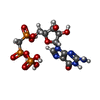

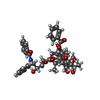


| #4: Chemical | ChemComp-G2P / #5: Chemical | ChemComp-MG / #6: Chemical | |
|---|
-Details
| Has ligand of interest | N |
|---|---|
| Has protein modification | Y |
-Experimental details
-Experiment
| Experiment | Method: ELECTRON MICROSCOPY |
|---|---|
| EM experiment | Aggregation state: FILAMENT / 3D reconstruction method: single particle reconstruction |
- Sample preparation
Sample preparation
| Component | Name: Complex of TTLL11 and two tubulin dimers / Type: COMPLEX / Entity ID: #1-#3 / Source: RECOMBINANT |
|---|---|
| Source (natural) | Organism:  Homo sapiens (human) Homo sapiens (human) |
| Source (recombinant) | Organism:  Homo sapiens (human) / Cell: HEK 293T Homo sapiens (human) / Cell: HEK 293T |
| Buffer solution | pH: 7 Details: 40 mM Tris-HCl, pH 7.0, 1 mM TCEP, 1 mM MgCl2, 5 % glycerol |
| Specimen | Conc.: 2 mg/ml / Embedding applied: NO / Shadowing applied: NO / Staining applied: NO / Vitrification applied: YES |
| Specimen support | Grid material: COPPER / Grid mesh size: 300 divisions/in. / Grid type: Quantifoil R2/1 |
| Vitrification | Instrument: LEICA EM GP / Cryogen name: ETHANE / Humidity: 90 % |
- Electron microscopy imaging
Electron microscopy imaging
| Experimental equipment |  Model: Titan Krios / Image courtesy: FEI Company |
|---|---|
| Microscopy | Model: TFS KRIOS |
| Electron gun | Electron source:  FIELD EMISSION GUN / Accelerating voltage: 300 kV / Illumination mode: FLOOD BEAM FIELD EMISSION GUN / Accelerating voltage: 300 kV / Illumination mode: FLOOD BEAM |
| Electron lens | Mode: BRIGHT FIELD / Nominal defocus max: 2000 nm / Nominal defocus min: 800 nm |
| Image recording | Electron dose: 30 e/Å2 / Film or detector model: FEI FALCON III (4k x 4k) |
- Processing
Processing
| CTF correction | Type: PHASE FLIPPING AND AMPLITUDE CORRECTION | ||||||||||||||||||||||||
|---|---|---|---|---|---|---|---|---|---|---|---|---|---|---|---|---|---|---|---|---|---|---|---|---|---|
| 3D reconstruction | Resolution: 3.28 Å / Resolution method: FSC 0.143 CUT-OFF / Num. of particles: 239587 / Symmetry type: POINT | ||||||||||||||||||||||||
| Atomic model building | Protocol: FLEXIBLE FIT | ||||||||||||||||||||||||
| Atomic model building | Accession code: AF-Q8NHH1-F1-v4 / Source name: AlphaFold / Type: in silico model | ||||||||||||||||||||||||
| Refine LS restraints |
|
 Movie
Movie Controller
Controller



 PDBj
PDBj

